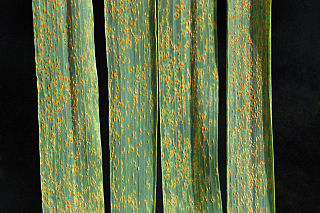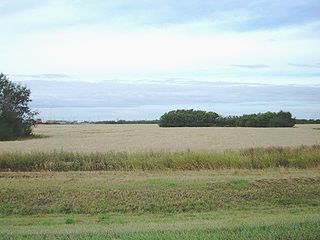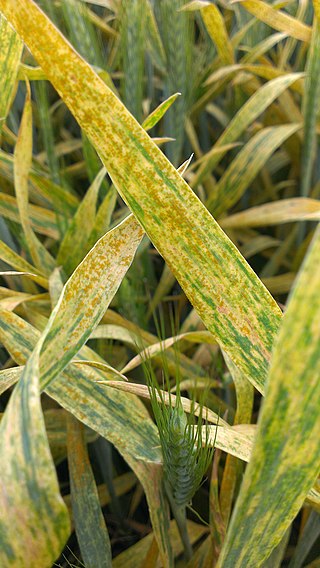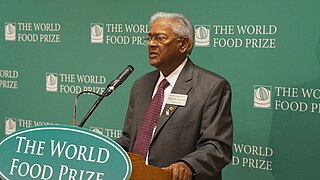
The oat, sometimes called the common oat, is a species of cereal grain grown for its seed, which is known by the same name. Oats appear to have been domesticated as a secondary crop, as their seeds resembled those of other cereals closely enough for them to be included by early cultivators. Oats tolerate cold winters less well than cereals such as wheat, barley, and rye, but need less summer heat and more rain, making them important in areas such as Northwest Europe that have cool wet summers. They can tolerate low-nutrient and acid soils. Oats grow thickly and vigorously, allowing them to outcompete many weeds, and compared to other cereals are relatively free from diseases.
Agriculture and Agri-Food Canada is the department of the Government of Canada responsible for the federal regulation of agriculture, including policies governing the production, processing, and marketing of all farm, food, and agri-based products. Agriculture in Canada is a shared jurisdiction and the department works with the provinces and territories in the development and delivery of policies and programs.

Stem rust, also known as cereal rust, black rust, red rust or red dust, is caused by the fungus Puccinia graminis, which causes significant disease in cereal crops. Crop species that are affected by the disease include bread wheat, durum wheat, barley and triticale. These diseases have affected cereal farming throughout history. The annual recurrence of stem rust of wheat in North Indian plains was discovered by K.C. Mehta. Since the 1950s, wheat strains bred to be resistant to stem rust have become available. Fungicides effective against stem rust are available as well.

Wheat leaf rust is a fungal disease that affects wheat, barley, rye stems, leaves and grains. In temperate zones it is destructive on winter wheat because the pathogen overwinters. Infections can lead up to 20% yield loss. The pathogen is a Puccinia rust fungus. It is the most prevalent of all the wheat rust diseases, occurring in most wheat-growing regions. It causes serious epidemics in North America, Mexico and South America and is a devastating seasonal disease in India. P. triticina is heteroecious, requiring two distinct hosts.

Canada is one of the largest agricultural producers and exporters in the world. As with other developed nations, the proportion of the population agriculture employed and agricultural GDP as a percentage of the national GDP fell dramatically over the 20th century, but it remains an important element of the Canadian economy. A wide range of agriculture is practised in Canada, from sprawling wheat fields of the prairies to summer produce of the Okanagan valley. In the federal government, overview of Canadian agriculture is the responsibility of the Department of Agriculture and Agri-Food.

Elvin Charles Stakman was an American plant pathologist who was a pioneer of methods of identifying and combatting disease in wheat. He became an internationally renowned phytopathologist for his studies of the genetics and epidemiology of stem rust. Stakman is credited with improving crop yields both in North America and worldwide as part of the Green Revolution.

Ug99 is a lineage of wheat stem rust, which is present in wheat fields in several countries in Africa and the Middle East and is predicted to spread rapidly through these regions and possibly further afield, potentially causing a wheat production disaster that would affect food security worldwide. In 2005 the noted green revolution pioneer Norman Borlaug brought great attention to the problem, and most subsequent efforts can be traced to his advocacy. It can cause up to 100% crop losses and is virulent against many resistance genes which have previously protected wheat against stem rust.

Agriculture in Saskatchewan is the production of various food, feed, or fiber commodities to fulfill domestic and international human and animal sustenance needs. The newest agricultural economy to be developed in renewable biofuel production or agricultural biomass which is marketed as ethanol or biodiesel. Plant cultivation and livestock production have abandoned subsistence agricultural practices in favor of intensive technological farming resulting in cash crops which contribute to the economy of Saskatchewan. The particular commodity produced is dependent upon its particular biogeography or ecozone of Geography of Saskatchewan. Agricultural techniques and activities have evolved over the years. The first nation nomadic hunter-gatherer lifestyle and the early immigrant ox and plow farmer proving up on his quarter section of land in no way resemble the present farmer operating huge amounts of land or livestock with their attendant technological mechanization. Challenges to the future of Saskatchewan agriculture include developing sustainable water management strategies for a cyclical drought prone climate in south western Saskatchewan, updating dryland farming techniques, stabilizing organic definitions or protocols and the decision to grow, or not to grow genetically modified foods. Domestically and internationally, some commodities have faced increased scrutiny from disease and the ensuing marketing issues.
John Hubert Craigie, was a Canadian plant pathologist. He is known for his "research and development of rust-resistant cereals which have been of vital significance to Canada as a cereal producing nation."

Wheat yellow rust, also known as wheat stripe rust, is one of the three major wheat rust diseases, along with stem rust of wheat and leaf rust.
Ruth Florence Allen (1879–1963) was an American botanist and plant pathologist and the first woman to earn her Ph.D. in botany from the University of Wisconsin. Her doctorate research focused on the reproduction and cell biology of ferns, particularly the phenomenon of apogamy. Later in her career, Allen shifted her focus to plant pathology. Her major contribution to the field of mycology was furthering the understanding of rust fungi, a group of economically important plant pathogens. Allen completed many studies on Puccinia graminis, once considered a catastrophically damaging disease-causing agent in cereal crops before the discovery of current management measures.

Agriculture in Finland is characterized by the northern climate and self-sufficiency in most major agricultural products. Its economic role is declining in terms of GNP and employment in primary production, but together with the food industry and forestry with which it is linked, it forms a significant part of the Finnish economy. The number of farms has steadily declined for the last decades. Between 2000 and 2012 their number fell from almost 80,000 in 2000 to about 60,000, while the amount of arable land has slightly increased to a total of almost 2.3 million hectares. Agriculture employed 125,000 people in 2010, which is a drop of 30 percent from 2000.

Margaret Brown Newton was a Canadian plant pathologist and mycologist internationally renowned for her pioneering research in stem rust Puccinia graminis, particularly for its effect on the staple Canadian agricultural product wheat.

Dr. Sanjaya Rajaram was an Indian-born Mexican scientist and winner of the 2014 World Food Prize. He was awarded this prize for his scientific research in developing 480 wheat varieties that have been released in 51 countries. This innovation has led to an increase in world wheat production – by more than 200 million tons – building upon the successes of the Green Revolution. The Government of India awarded him India's fourth- and third-highest civilian awards Padma Shri (2001) and Padma Bhushan (2022).
Karen Bailey is a retired research scientist who specialized in plant pathology and biopesticide development at Agriculture and Agri-Food Canada. Her research focused on developing alternatives to synthetic pesticides and improving plant health through integrated pest management strategies. She is internationally recognized for her expertise on soil-borne pathogens and biological control, and she has more than 250 publications, 23 patents, and 7 inventions disclosures in progress.
Vernon Douglas Burrows was a research scientist at Agriculture and Agri-Food Canada (AAFC) and an international authority on oat breeding and utilization. He bred and registered 28 varieties of oats, including AC Gehl, the “naked oat,” which is hulless and hairless and therefore easier to process and transport. In 2001 Burrows was appointed as Member of the Order of Canada, and in 2018 he was promoted to Officer of the Order of Canada for his research that has enhanced the production and nutritional value of oat-based foods.
For the American folk singer and songwriter, see Nancy Ames.
Sylvie Cloutier is a Canadian scientist. She is a specialist in molecular genetics at Agriculture and Agri-Food Canada's Ottawa Research and Development Centre and an adjunct professor at the University of Ottawa. She has co-led two Genome Canada Large Scale Applied Research projects of $11M each and has been involved in over 110 published research papers and made contributions to many books.
Jennifer Mitchell Fetch is a Canadian research scientist with Agriculture and Agri-Food Canada (AAFC) with expertise in oat breeding. She is known for running the only organic oat breeding program in Canada and helping with the development of several oat milling quality cultivars, including the first organically developed cultivar, AAC Oravena. Canada is the largest exporter of oats in the world, emphasizing the importance of developing new and improved cultivars for farmers. Canada is responsible for producing approximately 3 million tonnes of quality oats every year, with 90% being from Western Canada, where Mitchell Fetch focused her research and was the only Agriculture Canada oat breeder for years. Mitchell Fetch was employed by AAFC in 1998 and spent 22 years as an oat breeder before her retirement in 2020.










